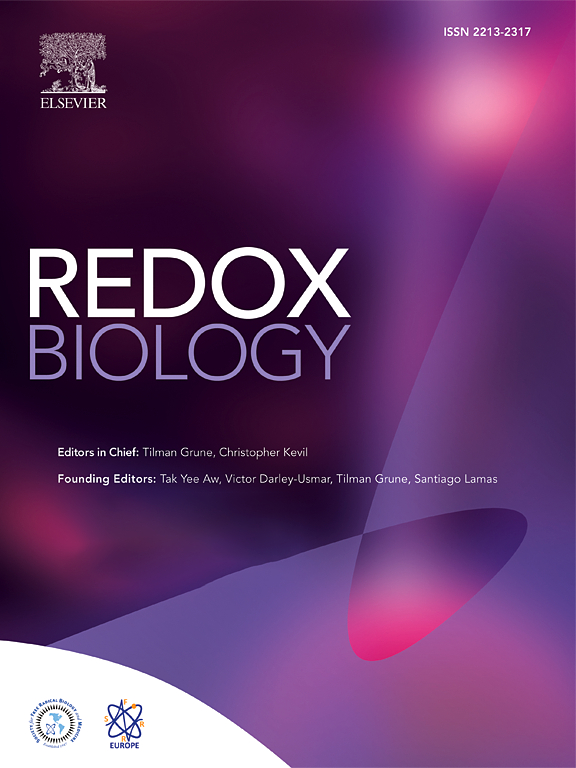荧光纳米金簇具有抗动脉粥样硬化的多重作用。
IF 10.7
1区 生物学
Q1 BIOCHEMISTRY & MOLECULAR BIOLOGY
引用次数: 0
摘要
动脉粥样硬化是全球主要的发病和死亡原因。具有降脂和/或抗炎特性的分子是抗动脉粥样硬化的潜在药物靶点。我们研究了荧光金纳米簇(FANC)的抗动脉粥样硬化作用,荧光金纳米簇是二氢硫辛酸(DHLA)包裹的2纳米金纳米粒子。我们评估了 FANC 通过连续腹腔给药(20 μM,每周 50 μl)或通过饮水(300 nM)对西式饮食喂养的载脂蛋白E缺陷小鼠 8 周的影响。FANC 可降低主动脉粥样斑块负荷、血清总胆固醇以及氧化应激标志物丙二醛和 4-羟基壬烯醛的水平。FANC 减轻了肝脏脂质沉积,改变了脂质平衡相关基因 HMGCR、SREBP、PCSK9 和 LDLR 的表达,其模式与使用依折麦布治疗的小鼠相似。FANC 还能抑制肠道对胆固醇的吸收,与依折麦布的作用相似。FANC 的降脂和抗动脉粥样硬化作用在西式饮食喂养的 LDLr 缺失小鼠中再次出现。FANC 通过 DHLA 与胰岛素受体 β(IRβ)结合,导致 AKT 激活。然而,与胰岛素也能结合 IRβ 激活 AKT 以诱导 HO-1 不同,FANC 对 AKT 的激活与人主动脉内皮细胞(HAECs)中 HO-1 的表达无关。另外,FANC上调NRF2,干扰KEAP1与NRF2的结合,促进KEAP1降解以释放NRF2进入核内,从而诱导HO-1,抑制ICAM-1和VCAM-1的表达。同样,FANC 可抑制氧化-LDL 诱导的 THP 衍生巨噬细胞对 HAECs 的附着。在巨噬细胞中,FANC 上调 ABCA1,并逆转 ox-LDL 诱导的胆固醇外流抑制。FANC 在体外的作用剂量为纳米摩尔。总之,我们的研究结果表明,FANC 对动脉粥样硬化具有新的作用和多种机制。本文章由计算机程序翻译,如有差异,请以英文原文为准。
Fluorescent gold nanoclusters possess multiple actions against atherosclerosis
Atherosclerosis caused major morbidity and mortality worldwide. Molecules possessing lipid-lowering and/or anti-inflammatory properties are potential druggable targets against atherosclerosis. We examined the anti-atherosclerotic effects of fluorescent gold nanoclusters (FANC), which were dihydrolipoic acid (DHLA)-capped 2-nm gold nanoparticles. We evaluated the 8-week effects of FANC in Western-type diet-fed ApoE-deficient mice by either continuous intraperitoneal delivery (20 μM, 50 μl weekly) or via drinking water (300 nM). FANC reduced aortic atheroma burden, serum total cholesterol, and oxidative stress markers malondialdehyde and 4-hydroxynonenal levels. FANC attenuated hepatic lipid deposit, with changed expression of lipid homeostasis-related genes HMGCR, SREBP, PCSK9, and LDLR in a pattern similar to mice treated with ezetimibe. FANC also inhibited intestinal cholesterol absorption, resembling the action of ezetimibe. The lipid-lowering and anti-atherosclerotic effects of FANC reappeared in Western-type diet-fed LDLr-deficient mice. FANC bound insulin receptor β (IRβ) via DHLA, leading to AKT activation. However, unlike insulin, which also bound IRβ to activate AKT to induce HO-1, activation of AKT by FANC was independent of HO-1 expression in human aortic endothelial cells (HAECs). Alternatively, FANC up-regulated NRF2, interfered the binding of KEAP1 to NRF2, and promoted KEAP1 degradation to free NRF2 for nuclear entry to induce HO-1 that suppressed the expression of ICAM-1 and VCAM-1. Consistently, FANC suppressed ox-LDL-induced enhanced attachment of THP-derived macrophages onto HAECs. In macrophages, FANC up-regulated ABCA1, and reversed ox-LDL-induced suppression of cholesterol efflux. FANC effected in vitro at nano moles. In conclusion, our findings showed novel actions and multiple mechanisms of FANC worked coherently against atherosclerosis.
求助全文
通过发布文献求助,成功后即可免费获取论文全文。
去求助
来源期刊

Redox Biology
BIOCHEMISTRY & MOLECULAR BIOLOGY-
CiteScore
19.90
自引率
3.50%
发文量
318
审稿时长
25 days
期刊介绍:
Redox Biology is the official journal of the Society for Redox Biology and Medicine and the Society for Free Radical Research-Europe. It is also affiliated with the International Society for Free Radical Research (SFRRI). This journal serves as a platform for publishing pioneering research, innovative methods, and comprehensive review articles in the field of redox biology, encompassing both health and disease.
Redox Biology welcomes various forms of contributions, including research articles (short or full communications), methods, mini-reviews, and commentaries. Through its diverse range of published content, Redox Biology aims to foster advancements and insights in the understanding of redox biology and its implications.
 求助内容:
求助内容: 应助结果提醒方式:
应助结果提醒方式:


